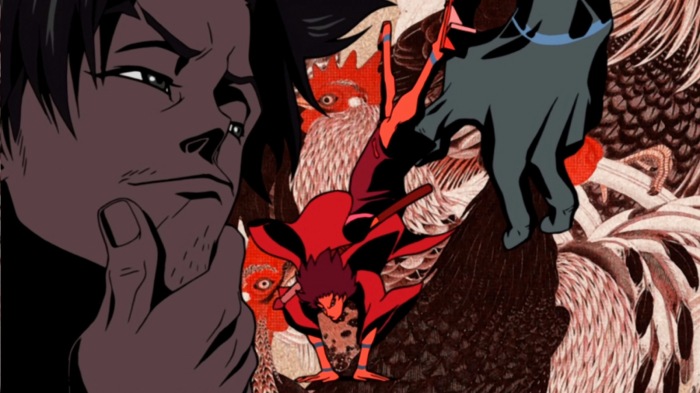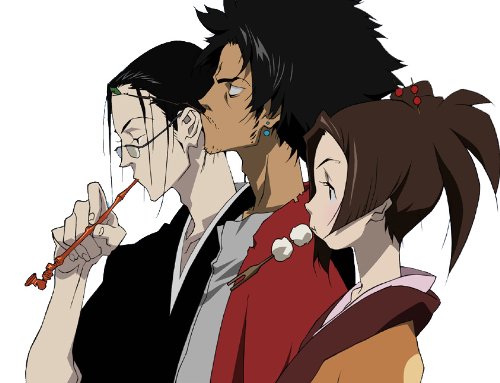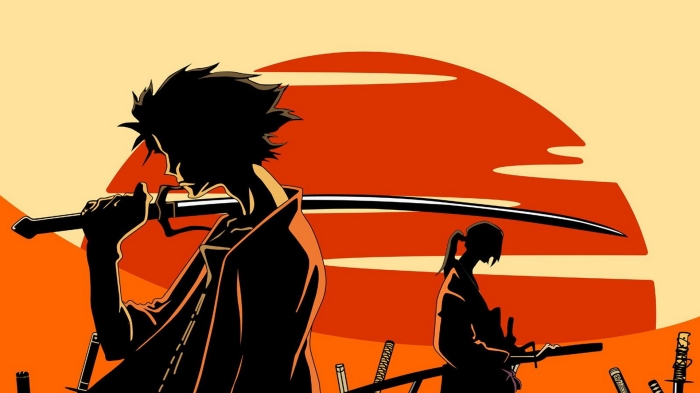I’m going to go back and criticize one of my “Anime as an Art Form” blog posts. Specifically, Cowboy Bebop. I was quite kind to Bebop the first time around, and I feel that it’s still necessary to make clear that it’s a great show, but I don’t feel like I quite fleshed out why Bebop works, and why it also fails. Bebop is reminiscent of Gunsmoke or Bonanza, the kind of show you want to sit back in a smoky room, swirling a brandy, and just take in. It harkens back to a different time, the show that doesn’t just exude cool, but basks in it, bathes in it, and towels off seductively in it…err, right.
But for all its flavor, Bebop was two things: slow and predictable. The pace of the show dragged as slow as its blues melodies, and each of the plot notes were visible from a mile away. To be fair, that was the mood of the genre it was exhibiting, but personally it never quite fit my tastes. Space westerns have been done to death, and I hit the Bebop train too late. Perhaps on a rainy day I could lay back and enjoy the visual montage that is Bebop, but truthfully I wanted something a little more left field.
Which takes us to our next show, Samurai Champloo.
Samurai Champloo
Genre: Action, Western, Comedy, (a genre unto itself?)
# of episodes: 26
Themes: Anachronism, Existentialism ennui
Watch: Netflix, Hulu, Funimation, and good ol’ Toonami on Adult Swim/Cartoon Network. English dub is acceptable on this one.
What is a champloo, anyways? “Blend” is what the dictionary tells me. An apt adjective for yet another one of Shinchiro Watanabe’s productions. Watanabe is the same director and producer as Bebop, and to call Samurai Champloo its spiritual successor would be an understatement. Champloo is Bebop transplanted in every way, yet this time around it works so much more efficiently, thanks in part to its Eastern setting and much more solid pacing.
Samurai Champloo is set during the Edo-period of Japan. “Set” is a bit of a misnomer. In reality, the setting itself is anachronistic to a modern setting of urban life. Samurai decked in kimonos and sideways-turned swords might as well be members of the N.W.A. Characters swagger in getas, pimped cars are replaced with pimped litters, and the entire hip-hop soundtrack scratches beats to sword swings. While famous historical events are weaved in and out of the plot points, and the major aesthetic remains of the shogunate, this is more “Edo in hip-hop” than “hip-hop in Edo.” Best of all, it works.
On close inspection it’s not surprising that it fits together so seamlessly. 90’s hip-hop had underlying anthems of chivalry to a gang and a code of the streets, so to re-transplant that back to ancestral roots doesn’t create quite the jolt you might believe. The same was true of the cowboy-and-jazz nature of space in Bebop, and if you found that anachronism enjoyable you will probably take a liking to Champloo.
The characters then. There’s Jin, the quiet ronin who plays the traditional stoic samurai/cowboy; Mugen, the rash and womanizing gangster/wanderer; and Fuu, the token damsel whose nature is as fickle as the wind she was named after. The plot is as simple as all three looking for “the samurai who smells of sunflowers.” The reality is it’s a show of unconnected fables and one-off moments. Watanabe’s shows are less about plot exposition and more about living in the world. They’re visual artpieces, not plot devices, so it comes as no surprise that Champloo isn’t a dialogue-heavy show. That being said, it does have more dialogue than Bebop, and its quality is par enough with the visuals to not detract (nor add) to the visual spectacle.
This all begs the question: can good television be spectacle alone? Perhaps on some level, no: part of the intellectual greatness of shows like The Wire and Breaking Bad stems from discourse. Yet at the same time, television is as much about the visual as it is about the audible. Whether it’s in the imperceptible slow pan-in on Anton Chigurh’s face during the coin-toss scene of No Country For Old Men, or the swooping camera over the beaches in The Longest Day, or whatever the heck is going on in 2001: A Space Odyssey, the camera serves as much purpose in building art as does the audio. For animation, this is its greatest strength: the ability to create what cannot be done on camera, or at least what can’t be done for cheap. Samurai Champloo uses this to its effect, splashing an anachronistic art style that could only be uncanny if done on live film, yet fits so cleanly in animation. Because of this, the thematic significance of characters out of their element doesn’t need to be padded with dialogue. The animation is already telling the audience all it needs to know about Jin’s clash with modernity with a garb and stance that befits historical Edo, yet doesn’t befit this fictional Edo. It doesn’t need to be explicitly made, because one of the major points of visual art is that it expresses that which is often unconsciously felt yet consciously is difficult to word.
So why Champloo over Bebop? Two reasons. One, I believe that Champloo’s anachronism comes across much more successfully than Bebop’s due in part to its removed, perhaps extreme nature from Western tradition. Shows like Star Trek, Babylon 5, and Firefly have already explored the whole “space frontier” concept. The “samurai frontier” is a much lesser known style, and I’d even argue that artistically Champloo’s style fits in a looser, more free-style way than Bebop’s slick attempt at jazz, western, and sci-fi. When Bebop’s elements fell apart, they fell hard, but I never got that impression from Champloo, which is a rare treat. Two, as stated before Bebop had pacing issues, was predictable, and expectant. Champloo is predictable and expectant, but lacks the pacing issues. So hey, score one for Champloo.



